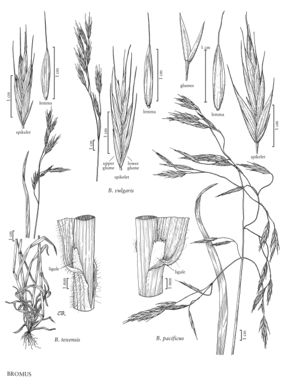Bromus pacificus
Plants perennial; not rhizomatous. Culms 60-170 cm, erect; nodes (5)6-8, pubescent; internodes usually glabrous, sometimes pubescent near the nodes. Sheaths pilose, midrib of the culm leaves not abruptly narrowed just below the collar; auricles absent; ligules 2-4 mm, glabrous, truncate, erose or lacerate; blades 20-35(37) mm long, 6-16 mm wide, flat, abaxial surfaces glabrous, adaxial surfaces pilose. Panicles 10-25 cm, open, nodding; branches ascending, spreading, or drooping. Spikelets 20-30 mm, elliptic to lanceolate, terete to moderately laterally compressed, with (4)6-10 florets. Glumes pubescent; lower glumes 6-8.5 mm, 1(3)-veined; upper glumes 8-11.5 mm, 3-veined, not mucronate; lemmas 10-12 mm, lanceolate, rounded over the midvein, backs pubescent, margins more densely so, apices acute, entire; awns 3.5-7 mm, straight, arising less than 1.5 mm below the lemma apices; anthers 2-4 mm. 2n = 28.
Distribution
Alaska, Oreg., Wash., B.C.
Discussion
Bromus pacificus grows in moist thickets, openings, and ravines along the Pacific coast from southeastern Alaska to northern California, with a few occurrences further inland.
Selected References
None.
